| c.AD 50 - 150 |
 The arrival in Poland of the Gothic people in the first and second centuries AD has a great impact on the Baltic population there, resulting in them moving towards eastern Lithuania. In all probability, due to the ethnic affinity of these peoples, peaceful relations are established. The appearance of various new groups of pottery, part of the Willenberg culture, testifies to the further merging of these ethnic groupings. The ancestors of the Galindians, Lets, Lithuanians, Natangians, Sambians, and Semigallians continue throughout the entire Early Iron Age to build stone cists in which they place urns of a family or kin, covering them with an earth barrow secured by a stone pavement from above and stone rings around. While available, Middle and Late La Tène fibulae are also imported and imitated. In marked contrast to Celtic and Germanic graves, however, weapons are extremely rare in Baltic graves. The inland Prussian tribes seem to live a rather peaceful life. Other Baltic tribes are now developing their own distinctive burial rites. Sudovians build stone barrows, Couronians place their dead in stone circles or rectangular walls, while their neighbours in central Lithuania use flat graves supporting tree-trunk coffins with stones. The differentiation of local burial rites from around this time permits modern scholars the chance of perceiving tribal borders between the various Baltic tribes, which thereafter remain unchanged in this region until the coming of the Germans. Until then, there is no evidence of migrations, shifts of population, or invasions of the Baltic lands by foreign peoples. The arrival in Poland of the Gothic people in the first and second centuries AD has a great impact on the Baltic population there, resulting in them moving towards eastern Lithuania. In all probability, due to the ethnic affinity of these peoples, peaceful relations are established. The appearance of various new groups of pottery, part of the Willenberg culture, testifies to the further merging of these ethnic groupings. The ancestors of the Galindians, Lets, Lithuanians, Natangians, Sambians, and Semigallians continue throughout the entire Early Iron Age to build stone cists in which they place urns of a family or kin, covering them with an earth barrow secured by a stone pavement from above and stone rings around. While available, Middle and Late La Tène fibulae are also imported and imitated. In marked contrast to Celtic and Germanic graves, however, weapons are extremely rare in Baltic graves. The inland Prussian tribes seem to live a rather peaceful life. Other Baltic tribes are now developing their own distinctive burial rites. Sudovians build stone barrows, Couronians place their dead in stone circles or rectangular walls, while their neighbours in central Lithuania use flat graves supporting tree-trunk coffins with stones. The differentiation of local burial rites from around this time permits modern scholars the chance of perceiving tribal borders between the various Baltic tribes, which thereafter remain unchanged in this region until the coming of the Germans. Until then, there is no evidence of migrations, shifts of population, or invasions of the Baltic lands by foreign peoples. 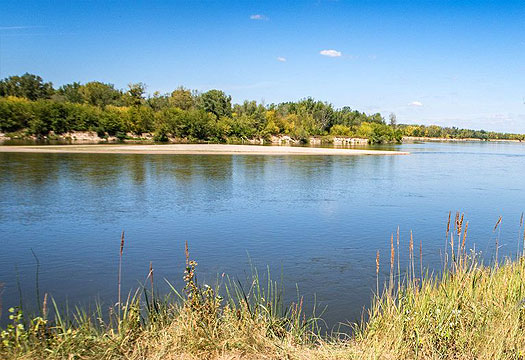 The mouth of the Vistula in the first century AD was an ideal route for settlement for groups coming south from Scandinavia, but also for groups migrating along the coast such as the speculated movement of Venedi Celts The mouth of the Vistula in the first century AD was an ideal route for settlement for groups coming south from Scandinavia, but also for groups migrating along the coast such as the speculated movement of Venedi Celts |
|
| c.150 - 200 |
Far from remaining settled where they are in Willenberg Poland, the Goths gradually renew their migration, now moving slowly southwards from the Oder and Vistula, heading on a path that will eventually take them into Ukraine. The migration could be caused by pressure from the Baltic tribes, early segments of the later Old Prussians and Lithuanians who are expanding back into territory they had lost to the Germanic tribes in the first century AD. |
|
| 5th century |
In the first half of the fifth century, there is some evidence of a new wave of invaders in Lithuania. There is every reason to believe that nomadic hordes (either the Huns or a fringe group related to or vassals of them) carry out raids on the forts of southern and eastern Lithuania. Traces of fires and three blade spearheads are later uncovered at the forts of Aukstadvaris, Kernave, Pasvonis, and Vilnius to support the idea. An increase in fortifications around hill forts and their associated villages, with the use of timber constructions and tamped clay for building ramparts, can be observed from the fifth century onwards, probably as a reaction to these raids and also to Slavic pressure (probably one and the same thing). The Moshchiny culture is the archaeological expression of the Eastern Galindians. By AD 400, the heavy traffic between the Balts and the Finno-Ugrians, which had reached its peak in the fourth century, is cut off. Some hill top villages and hill forts in the Baltic area become deserted; some show levels of destruction caused by fire. Those villages whose remains show continued habitation also show a marked degradation in material culture. This is the indirect proof of the disaster that befalls the eastern Baltic tribes, and an indication that the 'new wave of invaders' in Lithuania have ventured further east than that and have done far more damage. |
|
| 1009 |
 The annals of the town of Quedlinburg in Germany report the arrival of Saint Brunon, known more normally as Bonifatius, on missionary work among the Prussians. His attempt ends in failure, and it is believed he is killed together with his eighteen companions somewhere in the vicinity of the Lithuanian border (the first mention of 'Lithuania' in written sources). The annals of the town of Quedlinburg in Germany report the arrival of Saint Brunon, known more normally as Bonifatius, on missionary work among the Prussians. His attempt ends in failure, and it is believed he is killed together with his eighteen companions somewhere in the vicinity of the Lithuanian border (the first mention of 'Lithuania' in written sources). 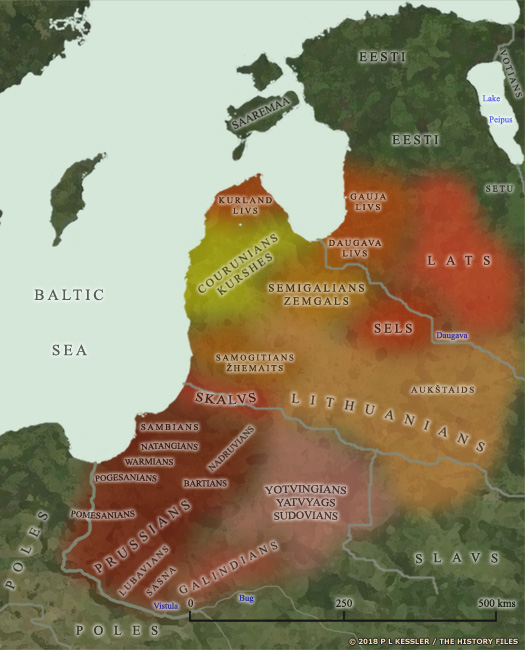 By about AD 1000 the final locations of the Baltic tribes were well known by the Germans who were beginning their attempts to subdue and control them, although the work would take a few centuries to complete and the Lithuanians would never be conquered by them (click or tap on map to view full sized) By about AD 1000 the final locations of the Baltic tribes were well known by the Germans who were beginning their attempts to subdue and control them, although the work would take a few centuries to complete and the Lithuanians would never be conquered by them (click or tap on map to view full sized) |
|
| 1167 |
Volodar Glebovich of Minsk opposes Vseslav ofPolotsk with an army which consists of a large number of Lithuanians. Vseslav is defeated and flees to Vitebsk. After being accepted by the Polotsk veche, Volodar pursues until he learns that Roman Rostislavich, prince of Smolensk, is coming to the aid of Vitebsk. Then he returns to his own lands around Vitebsk, leaving Polotsk to Vseslav. |
|
| 1180s |
It is around this time that a short-lived Lat principality which is subject to Polotsk appears in Gersik, or Gersike, situated on the right bank of the Daugava around 150 kilometres south of Riga. It only has two rulers before being conquered by the Order of the Knights of the Sword. In the same period the Lithuanians refuse to continue to serve as mercenaries of Polotsk and instead begin to form their own state. |
|
| before 1203 |
The Balts have come a long way towards producing contemporarily-modern feudal states. The largest or most powerful castle with a town has become the military and administrative centre for the tribal district. Five 'states' had already existed in the Couronian lands to be chronicled in the 870s by Rimbert. Now, at the beginning of the thirteenth century there are eight 'states' or districts with their own centres, each of which has several villages ('castellatura'). A similar pattern of separate districts pertains for all the other Baltic tribes. The more powerful feudal 'kings' extend their rule over two, three, four, or more districts. These 'kings' or chieftains possess the largest of all the castles. The most influential of them are called 'rex' or 'dux' or 'princeps' by chroniclers. The chronicles enumerate the names of the chieftains and even those of their subordinates. Power and land ownership are inherited. Prior to 1203, a semi-legendary 'Grand Principality of Lithuania' is supposed to exist, ruled by a single grand prince. In reality, the Lithuanians are not quite that united, with several dukes and princes presiding over various tribes and vassals, many of whom are loosely united by bonds of pagan religion, kinship, and trade. It is possible that this bonding process had begun when the region suffered Mongol incursions, but it is the arrival of German crusaders in the territory of the Lats and the Prussians which really sparks the process of unification amongst the Lithuanians. 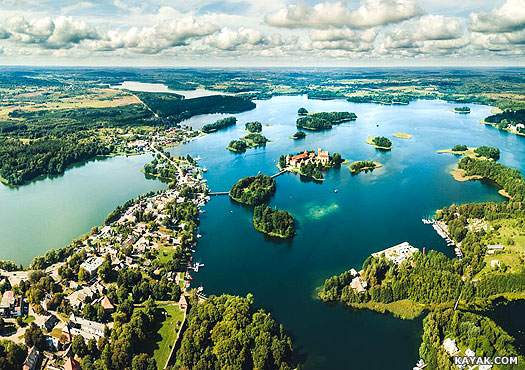 Lithuania's rivers have not only defined at least parts of its borders since its foundation, but one of them may even have provided the country with its name Lithuania's rivers have not only defined at least parts of its borders since its foundation, but one of them may even have provided the country with its name |
|
| before 1219 |
Ringaudas / Ringoldas |
Ruled in the Kernavė region. |
| fl 1219 |
Zivinbudas |
|
| 1219 |
The hierarchical structure of Baltic chieftainship is illustrated by the Chronicle of Volynia, which relates how twenty-one Lithuanian dukes come to sign a treaty between Lithuania and the Rus of Halych-Volynia. Of these, five - the most powerful amongst their number - are 'grand dukes', while the other sixteen are dukes of minor importance. From this it may be deduced that Lithuania is now ruled by a confederation of the most powerful chieftains. It is quite possible that such a system of government is also in existence in the other Baltic states and has been for some time. Mindaugas is mentioned as an elder duke when he attends the treaty signing. His father is mentioned in the Livonian Rhymed Chronicle as an unnamed powerful duke (later sources name him as Ringaudas). |
|
| ? - c.1235/38 |
Dausprungas |
Son of Ringaudas? |
| 1235? - 1236 |
Mindaugas / Mindouh |
Brother? United Lithuanian tribes and became first grand duke. |
| 1236 |
As soon as the Germans had began building their castles along the River Nemunas, they had met well-organised resistance from the Lithuanians. Following the shock defeat of the Order of the Knights of the Sword by the Samogitian and Semigallian tribes at the Battle of Schaulen (Saule or Šiauliai), Mindaugas is able to consolidate his control of Lithuania, creating a grand duchy. |
|
|
|
|
| Grand Duchy & Kingdom of Lithuania AD 1236 - 1263 In 1236 the Samogitians and Semigallians (situated between the Lithuanians and the Lats in what is now southern Latvia) decimated the Order of the Knights of the Sword at the Battle of Schaulen (Saule or Šiauliai), in what was the north-west of the Lithuanian tribal territories. At the same time, Mindaugas, who may have ruled for perhaps a year beforehand, was able consolidate his control of the eastern Lithuanian and southern Black-Rus (modern northern Belarus) territories, forming the grand duchy of Lithuania and Ruthenia, with a capital based at Navahradak. The state quickly came to consist of all the Lithuanian lands located mainly in the basin of the River Nemunas, taking in the tribes of Upyte, Deltuva, Neris, Dainava, Nalšia, plus Melnkrievija in the south, and the Samogitians (Zhemaits) in the west. Mindaugas' power was also acknowledged to a certain extent by the Skalvs, and Nadruvians, and elements of the Yotvingians, almost all Prussian tribes in the west and south, and the Sels in the north-eastern corner of Lithuania, with the result that the lands by the Upper Nemunas with their mixed Balto-Slavic population became part of the new Lithuanian state. The central power in Eastern Europe was now the growing Lithuanian state. It began its very rapid expansion to the east and south through Russian and Ukrainian lands. Between 1200-1263, Lithuanians fell upon Russians a total of seventy-five times. (Additional information from Encyclopedia Lituanica, Sužiedėlis Simas (Ed, Boston, 1970-1978), from Lithuania Ascending: A Pagan Empire Within East-Central Europe, 1295-1345, S C Rowell (Cambridge Studies in Medieval Life and Thought: Fourth Series, Cambridge University Press, 1994), and from External Link: The Balts, Marija Gimbutas (1963, previously available online thanks to Gabriella at Vaidilute, but still available as a PDF - click or tap on link to download or access it).) |
|
|
| 1236 - 1263 |
Mindaugas / Mindouh |
Converted to Christianity. Assassinated. |
| c.1240 |
Mindaugas makes the powerful Samogitians his vassals. Local rulers are allowed to remain in charge, especially as Lithuania's southern borders soon come under attack by the White Horde forces of Orda Khan as part of the general Mongol attack on Poland. |
|
| 1242 |
What remains of the fractured principality of Polotsk becomes a Lithuanian vassal state. Mindaugas places the soon-to-be Samogitian ruler, Tautvila, in command of the city of Polotsk and its surviving territories. |
|
| 1248 - 1251 |
Mindaugas commands Tautvilas, Edivydas, and Vykintas of the subjectSamogitians to capture theRus principality and city of Smolensk. They are promised with being able to keep what they conquer. The prince of Moscow, Mikhail Khorobrit, is defeated and killed on the banks of the River Protva, but they in turn are defeated by the resurgent Sviatoslav III of Vladimir-Suzdal. Mindaugas faces a stern test when conflict subsequently arises between him and Prince Daniel of Galicia (Halych) when the latter, along with the political powers in Livonia, and elements of the Samogitians (Zhemaits) and Yotvingians (who border the Old Prussians) who have been subdued by Mindaugas now rise against him. The conflict threatens to destroy the new state. With a mixture of politics and promises, Mindaugas wins over the Livonian Knights, and converts to Christianity in 1251. |
|
| 1253 - 1254 |
As the final stage of subduing the rebellion against him, Mindaugas is crowned king of Lithuania, using a crown sent to him by thePope (thereby officially recognising the Lithuanian state). He transfers part of the Samogitian territories to theLivonian Knights as a means of ensuring peace. The protection of the kingdom is maintained by Mindaugas from the legendary wooden castle of Voruta, one of a series of wooden castles which appear in Lithuania but which do not survive to the present day, with only hill forts remaining. Tautvilas of the Samogitians recognises him in 1254 and is givenPolotsk to command in return. 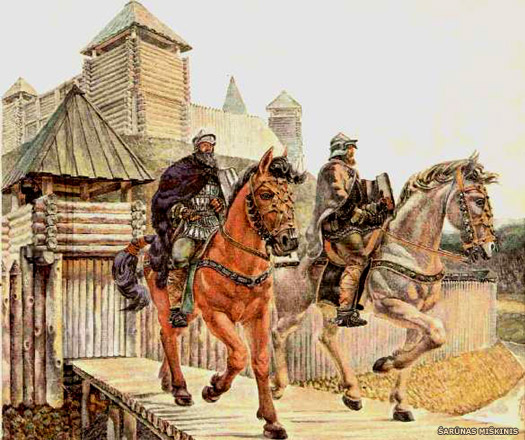 This artist's impression shows a typical Lithuanian wooden castle from this period during which the land was filled with them, approximately 450 in all, held by the nobility against the duchy's powerful enemies This artist's impression shows a typical Lithuanian wooden castle from this period during which the land was filled with them, approximately 450 in all, held by the nobility against the duchy's powerful enemies |
|
| 1259 |
At the end of a two year truce, the eager Samogitians inflict a defeat on the Livonian Knights at the Battle of Skuodas under the leadership of Treniota, nephew of Mindaugas. Their success encourages the Semigallians to rebel against the rule of the Knights. |
|
| 1260 - 1263 |
The Samogitians inflict a severe defeat on a joint army of Livonian Knights and Teutonic Knights at the Battle of Durbe in 1260 (now in south-western Latvia). Mindaugas is encouraged by Treniota to support the resulting rebellions against Teutonic rule, and his nephew organises military campaigns into Livonia until his own position has been strengthened. Then in 1263 he assassinates his uncle, returns the Lithuanians to paganism and takes over their governance. |
|
|
|
|
| Grand Duchy of Lithuania (& Ruthenia) AD 1263 - 1795 Treniota was the nephew of King Mindaugas and leader of the fierce Samogitian tribe during the defeats which were inflicted on the Livonian Knights. He also encouraged his uncle to give up the Christianity which he had only accepted in order to prevent attacks by the Teutonic Knights, a policy which had failed anyway. When Mindaugas began to question the alliance with his nephew, Treniota assassinated him and two of his sons, with the help of Daumantas, duke of Nalmas in northern Lithuania, and took over the reins of power in Lithuania, albeit only briefly before he was himself deposed by Vaisvilkas. All of this took place in the background of almost thirty years of uprisings against the Germans, with the Great Prussian Uprising doing a great deal to distract attention away from Lithuania. This gave the new grand duchy time to reorganise itself after four ducal assassinations in a row. Lithuanian expansion stalled for a while, until Gediminas came to the throne, but then expanded beyond all recognition. Throughout the fourteenth and early fifteenth centuries, devastating wars between the Germans and Lithuanians continued to be waged along the River Nemunas. Thanks to the clever and energetic leadership of Gediminas and then that of Algirdas and his heroic brother, Kęstutis, who spent all his life fighting against Germans, Lithuania grew into a powerful state instead of succumbing to the German threat. From the thirteenth century on, the central power in Eastern Europe was the growing Lithuanian state. It began its very rapid expansion to the east and south through Russian and Ukrainian lands, in time reaching the Black Sea. On horseback Lithuanians conquered Slavic lands, with Gediminas occupying nearly all of Belarus and north-western Ukraine (Volynia). Algirdas defeated the Tartars in 1362 near the Blue Waters in Podolia and took from them almost the entire basin of the Dnieper and Dniester. Later, Vytautas the Great, the most powerful of the rulers of Lithuania, annexed the Donets and Oka basins, surrounding Moscow from the west and south, making this area part of the Lithuanian empire. This expansion was directed toward lands which for the most part had been possessed by Lithuanians and other Eastern Baltic tribes in the prehistoric period. During its peak period (1362-1569), the empire covered 907,000 square kilometres (350,000 square miles. The huge state played an important role in protecting Western Europe, as well as its own lands, from being invaded by the Tartars. Ruthenia was a Latinisation of 'Rus', the Lithuanian-controlled Slavic lands to the south, which now form parts of Belarus, Russia, and Ukraine, with minor extensions into Poland and Slovakia. 'Black Ruthenia' came to be used for lands inhabited by Balts, and 'White Ruthenia' for the Slavs of Belarus ('belaya' or 'white' Rus). Much of Ruthenia was otherwise contained within the weakening state ofHalychyna-Volhynia. During this period, the peoples within the grand duchy, Couronians (Kurshes), the Lithuanians (of 'Highland' Lithuania), Old Prussians, Samogitians, Sels, Semgals, and Yotvingians, became consolidated as the Lithuanian people. (Additional information from Encyclopedia Lituanica, Sužiedėlis Simas (Ed, Boston, 1970-1978), from Lithuania Ascending: A Pagan Empire Within East-Central Europe, 1295-1345, S C Rowell (Cambridge Studies in Medieval Life and Thought: Fourth Series, Cambridge University Press, 1994), and from External Links: The Balts, Marija Gimbutas (1963, previously available online thanks to Gabriella at Vaidilute, but still available as a PDF - click or tap on link to download or access it), andWorldstatesman, and The Fragmentation & Decline of Kievan Rus, and Encyclopaedia.com.) |
|
|
| 1263 - 1264 |
Treniota |
Samogitian ruler. InPolotsk. Reverted to paganism. Assassinated. |
| 1264 |
Treniota's brief - pagan - reign of Lithuania is ended by the late Mindaugas' younger son, Vaisvilkas. He too reigns only briefly, although for three times as long as the treacherous Treniota. |
|
| 1264 - 1267 |
Vaisvilkas |
Son of Mindaugas. Seized throne. InPolotsk. Assassinated. |
| 1267 |
Svarnas, ruler of the powerful Kievan principality of Halych, secures the throne through his marriage to one of the daughters of Mindaugas. Svarnas' brother, Lev I of Halych, assassinates Vaisvilkas just to ensure that he is not challenged but also in revenge for not being handed a division of the Lithuanian lands. 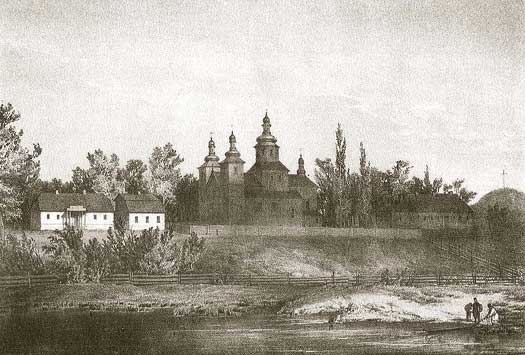 Veiselga Monastery, shown here in oils by Napoleon Orda, was apparently founded by Vaisvilkas, who twice retired to live a monastic life Veiselga Monastery, shown here in oils by Napoleon Orda, was apparently founded by Vaisvilkas, who twice retired to live a monastic life |
|
| 1267 - 1269 |
Svarnas of Galicia / John |
Prince of Halych. Assassinated. |
| 1270 - 1281/2 |
Traidenis / Traidjanis |
|
| 1274 - 1275 |
Smolensk is the last of the independent principalities of the Rus, but it now falls to Mongke Temur of theGolden Horde. The following year he defends his Rus vassals by dispatching a Mongol-Rus force to ward off the Lithuanians, an action requested by Duke Lev I of Halych-Volynia. |
|
| 1280 - 1281 |
The estate of Duke Skomantas of the Yotvingians is devastated. Skomantas is forced to flee to Black Ruthenia with three sons: Galms, Gedetes, and Rukals. Black Ruthenia is under Lithuanian control at this time, so he is relatively safe there. He soon returns, though, accepts baptism into the Roman Catholic church, and acknowledges the superiority of the Teutonic Knights. |
|
| 1282 |
Traidenis has managed to restore a level of stability to the state, reunifying the territories which form Lithuania and pushing back the rulers of Volynia who were threatening to take over, but his death leaves some doubt about the succession, especially in the minds of later scholars, owing to a lack of chronicling for the period. |
|
| 1282/83 - 1285 |
Daumantas |
The same as Daumantas of Pskov? |
| 1283 |
The Teutonic Knights continue to advance north through Prussia, and having conquered the lands of the Skalvs and part of that of the Yotvingians, they drive the Nadruvians to the River Nemunas in 1283, right on the border with Lithuania. The population of these areas is killed off, with only a few managing to escape across the border. |
|
| 1285 - 1291 |
Butigeidis |
First certain member of the Gediminid dynasty. |
| 1291 - 1294 |
Pukuveras / Butvydas |
Brother. Samogitian ruler. |
| 1294 |
Pukuveras' accession to the Lithuanian throne unites Samogitia to the crown on a permanent basis. The son of Pukuveras rules both as a single political entity. |
|
| 1295 - 1316 |
Viten / Vytenis |
Son. |
| 1316 - 1341 |
Gediminas / Hedymin |
Brother. |
| 1307 |
The brother of Gediminas, Vainius, secures the rule of the principality of Polotsk from the archbishopric ofRiga. Successive Lithuanian rulers in Polotsk help in fending off attacks by the Livonian Knights. |
|
| 1321 |
In or around this year (the dating is uncertain as the various chronicles which cover this event are only written down afterwards), Lithuania meetsKyiv in battle. Prince Stanislav Ivanovich is allied to the principalities of Pereyaslavl and Bryansk under Oleg and Roman respectively, but their joint forces are defeated at the Battle of the River Irpin. Kyiv now falls under Lithuanian influence, although the city itself successfully withstands a siege. |
|
| 1323 |
Gediminas transfers the Lithuanian capital to Vilnius. During his reign he also expands Lithuanian control over the Bela-Rus in the south, Vitebsk in the east, and Volynia in the south-east. TheGolden Horde Mongols begin to perceive the growing power of the Lithuanians as a direct threat to their hegemony over theRus. As a result, theMuscovites are soon granted extra powers to counter this threat. |
|
| 1326 |
Peter von Dusburg writes that in the Prussian province of Nadruva, in the place called Romuva, there is a powerful priest named Krivė, whom the people regarded as pope, and whose dominion extends not only over Nadruva, but also over Couronia, Lithuania, and Semigallia. The only such 'pope' known to recorded history, Krivė is highly respected by the kings, nobility and common people, and his rule covers almost all of the Baltic lands during the wars against the Teutonic Knights. |
|
| 1330 |
Lithuania defeats the boyars of the Rus and occupies Kyiv and its surrounding territory. The loss of this vassal state by the Golden Horde removes not only it from their control, but also cuts off Wallachia whose ruler, Basarab I, effectively becomes independent, although this has increasingly been the case for several years. 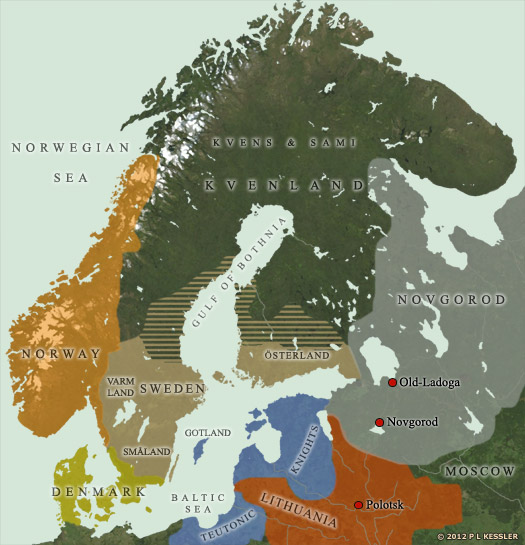 By around AD 1300 the Swedes and Norse had taken full control of southern Scandinavia and were starting to extend their influence northwards, while the Swedes were also becoming heavily involved in what is now southern Finland (click or tap on map to view full sized) By around AD 1300 the Swedes and Norse had taken full control of southern Scandinavia and were starting to extend their influence northwards, while the Swedes were also becoming heavily involved in what is now southern Finland (click or tap on map to view full sized) |
|
| ? - 1336? |
Margiris |
Duke of the Lithuanians. Died at Pilėnai? |
| 1336 |
During the protracted wars between the Germans and Lithuanians, the annalists who described the gruesome fights and sieges in Lithuania often express shocked surprise at seeing how readily the Lithuanians take their own lives. The most horrifying incident occurs in this year at the castle of Pilėnai on the River Nemunas. When the Lithuanians perceive that they can no longer hold out against the German onslaught, they kindle a huge fire, throw all their possessions and treasures into it, kill their wives and children, and then offer up their necks to their chief, the duke, Margiris, for decapitation. An old woman also uses an axe to decapitate a hundred men who voluntarily accept death at her hands. When the enemy break in, she splits in two her own head with the same axe. |
|
| 1341/2 - 1345 |
Jaunutis |
Son. |
| 1341 - 1377 |
Algirdas / Olgierd / Alhierd |
Brother. |
| 1341 - 1377 |
Algirdas expands Lithuanian territory further eastwards, bringing it into conflict with the grand duchy of Moscow. Escalating into the Lithuanian-Muscovite War (1368-1372), his initial opponent is Grand Prince Simeon, who has been granted extra powers by his overlord, Ozbeg Khan of theGolden Horde specifically to counter the Lithuanian threat. In 1342 Algirdas' son, Andrei, is made prince of Polotsk. The Battle of Blue Waters in either autumn 1362 or winter 1363 takes place on the banks of the River Syniukha, a tributary of the Bug in modernUkraine. Grand Duke Algirdas and his Lithuanian army decisively defeats the Golden Horde. The victory deliversKyiv very firmly into Lithuanian hands, along with a large swathe of modern Ukraine and access to the Black Sea. |
|
| 1377 - 1381 |
Jagiello / Jagiello |
Son. Converted. m Jadwiga. Became Wladyslaw V ofPoland. |
| 1377 |
Jagiello forces the principality of Polotsk to accept his loyal brother, Skirgaila, in favour of Andrei, whom he sees as a rival. |
|
| 1379 |
Bishop Dietrich of Dorpat hates the Livonian Knights with some intensity, so much so that he forms a coalition against the Knights with Lithuania, Mecklenburg and the notorious Victual Brothers who are Baltic pirates. The Knights invade the bishopric but achieve no success. In the end their lack of results removes from them the right to demand military service from theLivonian bishops. |
|
| 1381 |
While Jagiello is away, attempting to reinforce his brother's rule in Polotsk, his uncle, Kestutis, removes the throne from his control, triggering the Lithuanian Civil War (1381-1384). Andrei Olgerdovich almost immediately regains control ofPolotsk thanks to Kestutis, but no longer necessarily on behalf of the Lithuanian throne. Now he is a vassal of theLivonian Knights. Eventually Jagiello manages to win back control over the country. |
|
| 1381 - 1382 |
Kestutis / Kiejstut |
Brother of Algirdas. Ruler of Samogitia. |
| 1382 - 1401 |
Jogaila / Jagiello |
Restored. Accepted Christianity. Also king of Poland (1386-1434). |
| 1385 - 1386 |
The Union of Kreva (Krewo) is agreed by Jagiello as the only certain way to halt the crusading attacks by Poland, the Teutonic Knights and Moscow. The union includes the throne of Poland in return for the Catholic Christianisation of the Lithuanians. In 1386, Jagiello becomes king of Poland under the name Wladyslaw Jagiello, and his brother, Vladimir Olgerdovich, from his base inKyiv swears his allegiance. The Orthodox, Rus, nobles in the country are reduced to second class status as the Catholic nobles (or boyars) gain the best positions, but as Lithuania finds itself part of Poland and ruled in part by Poles, even the Catholic nobles are not pleased with the situation. |
|
| 1387 |
With Jagiello's conversion to Christianity, Lithuania becomes the last state in Europe to end its pre-Christian paganism (although the Lithuanian Zemaitija - the Samogitians - are not converted until after 1410). As he is now king of a far larger domain than just Lithuania, Jagiello appoints governors to handle Lithuania's day-to-day affairs but, unhappy with the situation, one of them by the name of Vytautas is supported by the nobles in his fight for power. In the same year Jagiello attacks Polotsk to the east and the Livonian Knights do not protect it, virtually gifting it to its attackers. |
|
| 1387 - 1390 |
Skirgaila Ivan |
Son. Governor of Samogitia for Jagiello. InKyiv (1393). |
| 1389 - 1390 |
Klemensas / Klemens Moskorzowski |
Governor in Lithuania for Jagiello. |
| 1390 - 1392 |
Jasius / Jan Olesnicki |
Governor in Lithuania for Jagiello. |
| 1392 |
Vytautas is successful in gaining Jagiello's concession of power in Lithuania, and rules the country as great prince, while Jagiello concentrates on his Polish domains. |
|
| 1392 - 1401 |
Vytautas |
Governor of Samogitia for Jagiello. Became grand duke in 1401. |
| 1392 - 1394 |
In his role as great prince, Vytautas begins a programme of replacing the regional Lithuanian dukes with regents in an attempt to centralise the state. The programme swiftly turns into the systematic removal of all dukes, not just disloyal ones. In 1393, Volodymyr-Volynskyi is confiscated from Feodor, son of Liubartas, while Novhorod-Siverskyi is taken from Kaributas, and Vitebsk from Švitrigaila. In 1394, Vytautas and Skirgaila Ivan of Samogitia march against Vladimir, duke of Kyiv. He surrenders without offering battle to be replaced by Skirgaila himself while Vladimir is moved to the principality of Slutsk. |
|
| 1397 |
The principality of Polotsk is abolished and becomes an administrative division of Lithuania, known as the Polotsk Voivodeship. |
|
| 1398 - 1411 |
The duchy of Samogitia is briefly conquered by the Teutonic Knights, before being recovered by Lithuania. |
|
| 1401 - 1430 |
Vytautas / Witold the Great |
Son of Kestutis. 'Regent' (1392-1401), then grand duke. |
| 1410 |
The Teutonic Knights of East Prussia are crushed at the Battle of Tannenberg by Polish and Lithuanian forces under Jagiello's leadership, halting the eastward expansion of the Knights. The Polish-Lithuanian union has borne a much greater level success than could have been expected in terms of limiting the knights. That union now becomes dominant for a time over Eastern Europe. Under Vytautas, Lithuania reaches the height of its territorial expansion, the equivalent size of fifteen modern Lithuanias, by taking Smolensk. 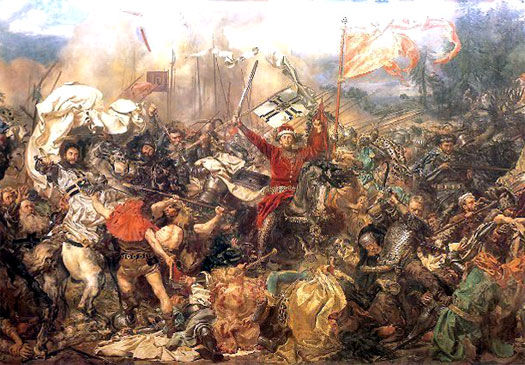 Moscow fought a series of wars against the then-dominant Grand Duchy of Lithuania & Ruthenia (the latter being western Rus) during the fifteenth century, but Moscow's eventual victory would present it with new threats, such as the Tartars of the powerful Crimean khanate (click or tap on image to view full sized) Moscow fought a series of wars against the then-dominant Grand Duchy of Lithuania & Ruthenia (the latter being western Rus) during the fifteenth century, but Moscow's eventual victory would present it with new threats, such as the Tartars of the powerful Crimean khanate (click or tap on image to view full sized) |
|
| 1411 |
Jalal ad Din, son of the powerful Toqtamish Khan who had reunified the Golden Horde, has been in exile for some years. He has taken part in the Battle of Tannenberg alongside the Lithuanians, and it is with Lithuanian support that he is now able to overthrow Temur Khan and regain his rightful place as ruler of the Golden Horde. Unfortunately, after a brief reign in which he writes a history of the Mongol empire, he is murdered by his brother, Karim Berdi. |
|
| 1422 |
The Teutonic Knights officially cede Samogitia to Lithuania under the terms of the Treaty of Melno. In the same year, Vytautas accepts an offer by the Hussites to take the crown of[Bohemia](EasternBohemia.htm#House of Luxembourg), and sends his deputy, Zygmunt Koribut, there. By now he has already raided the Rus, and subordinated Novgorod and Pskov, and even Moscow comes under Lithuania's influence in 1425. Vytautas is also acknowledged by the khans of Tatar. |
|
| 1429 - 1430 |
At the assembly of eastern and Central European leaders, held in Lutsk (now in Ukraine but at this time part of Lithuania), Holy Roman Emperor Sigismund von Luxembourg offers Lithuania a crown. In 1430, protests are made by the Polish Royal Council in their efforts to deny Lithuania crown status which would divide the union and take away half of Jagiello's holdings. Poland refuses passage to the emperor's envoys and their offering of a crown to Lithuania. The coronation of Vytautas in Vilnius fails. On 27 October, Vytautas dies (or is killed). His remains are entombed in Vilnius Cathedral (then known as St Stanislaus' Church). Jagiello grants the title of great prince of Lithuania to his brother, Swidrygiello. |
|
| 1430 - 1432 |
Swidrygiello / Svitrigaila |
Brother of Jagiello. Retreated toKyiv andPolotsk. |
| 1430 - 1432 |
Swidrygiello (otherwise known as Boleslav) attempts to implement Vytautas' goal of achieving a coronation. However, he is forcibly removed from power due to the efforts of Polish politicians. He is forced to retreat eastwards, finding protection inPolotsk and using his only secure holdings in Kyiv and Volynia. In the end he proves to be too old (at seventy or eighty) to continue to fight. |
|
| 1432 - 1440 |
Zygmunt / Sigismund |
Brother of Vytautas. Murdered by conspirators. |
| 1435 |
Zygmunt has strengthened his position by granting personal immunity to the nobles of the state, including those in the lands of Rus. Now he crushes the opposition forces of Swidrygiello and his ally, the Livonian Knights. This proves to be the last invasion into Lithuania to be carried out by the Knights. |
|
| 1440 - 1492 |
Kazimierz / Casimir |
Son of Jagiello. Also king of Poland (1446-1492). |
| 1440 |
Alexander Olelkovich is the son of Olelko Volodymyrovych of Slutsk-Kapyl who himself is the son of Vladimir Olgerdovich, former prince of Kyiv in 1363-1394. He is able to restore the family's hold on Kyiv for the Lithuanian crown. |
|
| 1446 |
Grand Duke Casimir gains the throne of Poland and becomes Casimir IV, king of Poland, as well as retaining command of the grand duchy. The union of two thrones is renewed on a personal basis (except between 1492-1501). Firstly due to Casimir's age, and then due to his responsibilities in Poland, real power in Lithuania is concentrated in the hands of the most powerful nobles, the 'Pans' Rada' or Council of Masters ('pans' is 'master' or 'mister' in Polish and[Czech](EasternBohemia.htm#House of Luxembourg), a title of nobility at the time, while 'rada' means council). Their power grows steadily. |
|
| 1471 |
The Jagiello dynasty gains control ofBohemia in the form of Ladislas II. His successor is a member of the same dynasty, his son, Louis. |
|
| 1480 |
In alliance with the khans of theCrimea, Moscow's Ivan III refuses tribute to the Great Horde. The latter, now allied to Lithuania, attempts an invasion of Moscow's territory but this fails. The independence of Moscow is confirmed. |
|
| 1492 - 1506 |
Alexander |
Son. Also king of Poland (1501-1506) upon his brother's death. |
| 1494 |
Ivan III signs a peace agreement with Stanislovas Janavicius of Samogitia, while his daughter, Helen, is married to the weak Alexander of Lithuania. The marriage does not protect Alexander from the looming threat of war against Moscow. |
|
| 1500 |
The Lithuanian state is forced to begin its defensive wars against the grand duchy of Moscow when the latter begins to lay claim to the Russian lands within the grand duchy. However, the Rus (Ruthenian) population remains loyal to Lithuania and Moscow's efforts are resisted. To the south the khanate of Crimea sometimes raids across the border to collect slaves - a thriving industry amongst the khanates. 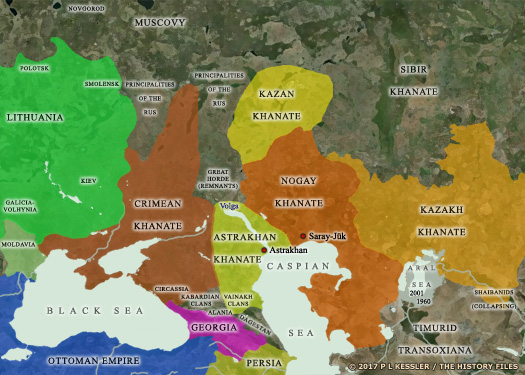 The Mongol empire created by Chingiz Khan gradually broke up over the course of three hundred years until, by around AD 1500, it had fragmented into several more-or-less stable khanates which vied for power and influence, while fending off the Ottoman empire to the south and Moscow state to the north (click or tap on map to view full sized) The Mongol empire created by Chingiz Khan gradually broke up over the course of three hundred years until, by around AD 1500, it had fragmented into several more-or-less stable khanates which vied for power and influence, while fending off the Ottoman empire to the south and Moscow state to the north (click or tap on map to view full sized) |
|
| 1506 - 1544 |
Sigismund I |
Brother. Also king of Poland. |
| 1513 - 1514 |
Sigismund loses Smolensk following a concerted effort by Moscow to take this eastern stronghold, but Lithuania finds some recompense in the following year when it smashes Moscow's army near Orsha. |
|
| 1526 |
Following a devastating defeat at the Battle of Mohács and the death of Louis, the Jagiello dynasty losesHungary and Bohemia to the [ Habsburgs](GermanyAustria.htm#Habsburg Archdukes). The defeat effectively destroys the dynasty's dream of effecting the 'Jaigello dynasty idea' wherein Lithuania, Poland, Bohemia, and Hungary are drawn together in union. The dream lives on in a more modest form for some years but is never realised. |
|
| 1529 |
The first Lithuanian Statute is drawn up. The state system, governmental and administrative organs, and the status of the privileged nobility are legally formulated by virtue of the Statute. |
|
| 1537 |
A peace treaty is concluded between Lithuania and Moscow in order to end nearly four decades of warfare between the two countries. However, Lithuanian relations with Moscow remain the most important concern as the Rus state begins to evolve into Russia. |
|
| 1544 - 1569 |
Sigismund II Augustus |
Son. King of Poland (1548-1572) & grand duke of[Livonia](EasternLatvia.htm#Polish Governors) (1566). |
| 1548 |
Having until now been fulfilling the role of grand duke of Lithuania alone, upon his father's death, Sigismund II assumes the crown of Poland. He is the last to hold the crown in personal union, with the more formal commonwealth being initiated by his successor. |
|
| 1558 - 1562 |
Following Russian provocation and the conquest of Dorpat, the Livonian Wars erupt in the Baltic states in 1558. The Livonian Knights and the archbishop of Riga seek help from Sigismund II, pawning five Order castles and two archbishopric castles together with their surrounding territory to help procure it. However, the army of the Livonian Knights is completely destroyed by the Russians at the Battle of Ergeme in 1560, and a year later, on 29 November 1561, the master of the Order, Gotthard Kettler, acknowledges the supreme power of Grand Duke Sigismund over all areas regarding the Order, including its territories, formally dissolving the Livonian Knights. By means of this, Lithuania gains [Livonia](EasternLatvia.htm#Polish Governors) and the archbishopric of Riga, along with the bishopric of Courland from the Danes. The territory of the Semigallians is joined to Courland to form a vassal duchy. 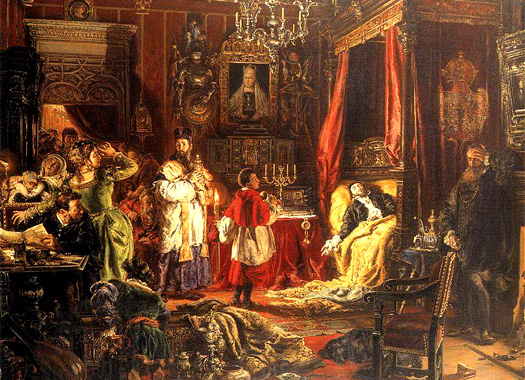 The death of Sigismund II Augustus, the last hereditary Lithuanian ruler of Poland as depicted by Jan Matejko, which signalled the end of Lithuania's independence from Poland The death of Sigismund II Augustus, the last hereditary Lithuanian ruler of Poland as depicted by Jan Matejko, which signalled the end of Lithuania's independence from Poland |
|
| 1569 - 1795 |
From the early sixteenth century, Lithuania had begun to lose her eastern provinces on the upper Volga, Oka, and Donets, to the Russians. The growing threat from Moscow forces Lithuania to conclude a political treaty with Poland in 1569 and cede her Ukrainian lands to Poland. The Union of Poland-Lithuania, Ruthenia, [Livonia](EasternLatvia.htm#Polish Governors), Polotsk, and Samogitia is effected, establishing the Commonwealth of Poland. Sigismund becomes king of a united Poland-Lithuania. From this point on, Lithuania's fate is tied to that of Poland until the joint kingdoms are extinguished in 1795 and Lithuania is taken entirely by the Russian empire. |
|
|
|
|
| Russian Governors of Lithuania (Vilna Governorate) AD 1795 - 1915 Incorporating the Pale of Settlement The Livonian Wars of 1558-1583 had allowed Sweden to take control of the Baltic states, but the Great Northern War at the start of the eighteenth century ended that control. The Russian empire had been building its strength and territories over the intervening time and was now the dominant regional force. In 1710 Russia secured control of much of the territory that would form modern Estonia. The Third Partition of the Polish-Lithuanian commonwealth in 1795 then brought about the total disappearance of the Lithuanian state, although Russia had already taken chunks of Lithuanian territory in the first two partitions of 1772 and 1793. For the next two centuries, the country remained a province within the mighty Russian empire until its dissolution towards the end of the First World War. Until then it was controlled by local governors. Sometimes known as the Vilnа Governorate between 1801-1840, it was controlled from Vilnius. From 1791, Russia also began to administer an area known as the Pale of Settlement. Initially this was small, but it increased greatly from 1793 and the Second Partition of the former commonwealth. By the mid-nineteenth century it incorporated modern Belarus (eastern Poland at the time), eastern [Latvia](EasternLatvia.htm#Russian Governors), Lithuania, the province of Bessarabia (modern Moldova), and western Ukraine. Having formerly been citizens of the defunct commonwealth, the Jewish Diaspora population of the 'Pale' (mainly Ashkenazi Jews) was restricted from moving eastwards into Russia proper. (Information by Peter Kessler, with additional information from The History of the Baltic Countries, Zigmantas Kiaupa, Ain Mäesalu, Ago Pajur, & Gvido Straube (Eds, Estonia 2008), and from External Links: BBC Country Profiles, and Lithuania in the 21st Century, Stanislas Klass (2010), and Jewish Encyclopaedia.) |
|
|
| 1795 - 1796 |
? |
Military governor, name unknown. |
| 1795 |
The joint kingdoms of Poland-Lithuania have been extinguished, with Prince Nikolay Vasilyevich Repnin-Obolensky having played a key role in their dissolution. Now overseen by the Vila governate, Lithuania is submerged within imperialRussia. Prince Repnin also fulfils the role of governor-general of theBaltic Provinces between 1792-1798. 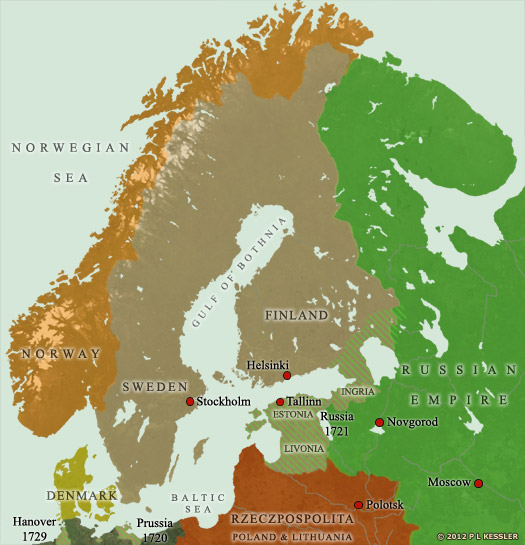 This map shows the Nordic borders following the conclusion of the Great Northern War in 1721, after which large swathes of eastern territory changed hands (click or tap on map to view full sized) This map shows the Nordic borders following the conclusion of the Great Northern War in 1721, after which large swathes of eastern territory changed hands (click or tap on map to view full sized) |
|
| 1796 - 1798 |
Nikolay Vasilyevich Repnin |
Repnins key in dissolution of Polish-Lithuanian commonwealth. |
| 1798 - 1799 |
Moritz Lacy |
|
| 1799 |
The Second Coalition is formed by[ Austria](GermanyAustria.htm#Habsburg Archdukes %28Lorraine%29) and Russia against [France](FranceFranks.htm#First Republic). It ends in Austrian defeat at the Battle of Marengo, which eventually secures the French client republics in the [Netherlands](FranceHolland.htm#House of Orange-Nassau) and Italy. |
|
| 1799 - 1801 |
Mikhail Illarionovich Golenschev-Kutuzov |
Leading general and governor ofCrimea (1787). |
| 1801 - 1806 |
Levin August Theophil F Bennigsen |
Hanoverian. Appointed by Alexander I. |
| 1805 - 1807 |
The Third Coalition is formed against[France](FranceFranks.htm#First Empire) so, in a swift campaign, Napoleon marches east, occupies the [Austrian](GermanyAustria.htm#Habsburg Archdukes %28Lorraine%29) capital of Vienna, and defeats large armies of Austrians and Russians at Austerlitz. The coalition lies in ruins. Former governor of Vilnius, Mikhail Kutuzov, commanded the Russian corps that had opposed Napoleon's march on Vienna. Levin von Bennigsen leaved Vilnius in 1806 to command one of the Russian armies which continue to operate against Napoleon. He takes part in the Battle of Pultusk at the end of the year and the Battle of Eylau in 1807. Flying high in the eyes of the emperor at this time, his fortunes crash in the crushing Russian defeat at Friedland in June 1807. |
|
| 1806 - 1809 |
Aleksandr M Rimsky-Korsakov |
Russian general. |
| 1809 - 1811 |
Mikhail Illarionovich Golenschev-Kutuzov |
Second term. Commanded 1812 defence of Russia. |
| 1811 - 1812 |
Ivan Stepanovich Guriel |
Assistant governor. |
| 1812 |
Aleksandr M Rimsky-Korsakov |
Second term. Ordered to withdraw at the [French](FranceFranks.htm#First Empire) advance. |
| 1812 |
Napoleon invades the Russian empire with one of the largest armies Europe has ever seen, occupying the Baltic States for several months until he is forced to drag his [French](FranceFranks.htm#First Empire)-led army back to Germany. Russian control of Lithuania is immediately restored. As the Lithuanians welcomed Napoleon as a liberator, any thoughts of a relaxation of controls are replaced by a policy of Russification. 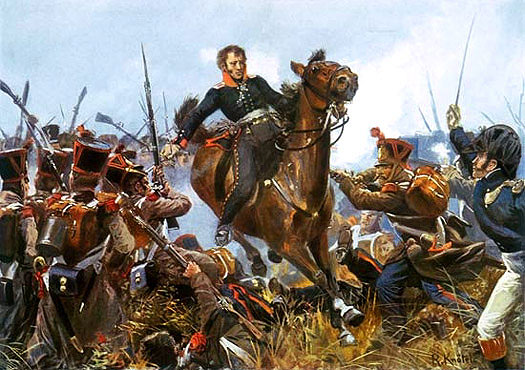 French grenadiers of the line defend against an attack by Prussian infantry in the three-day Battle of Leipzig in October 1813, dubbed the 'Battle of the Nations' due to the number of states involved, in this 1914 painting by Richard Knötel French grenadiers of the line defend against an attack by Prussian infantry in the three-day Battle of Leipzig in October 1813, dubbed the 'Battle of the Nations' due to the number of states involved, in this 1914 painting by Richard Knötel |
|
| 1812 - 1830 |
Aleksandr M Rimsky-Korsakov |
Restored. Recalled and went into retirement. |
| 1831 |
Aleksandr Vasilyevich Khrapovickiy |
|
| 1831 - 1840 |
Nikolai Andreyevich Dolgorukov |
|
| 1840 - 1850 |
Fyodor Yakovlevich Mirkovich |
Former military administrator of[Moldavia](EasternMoldavia.htm#Tax Farmer) &[Wallachia](EasternWallachia.htm#Tax Farmer) (1828). |
| 1850 - 1855 |
Ilya Gavrilovich Bibikov |
|
| 1855 - 1863 |
Vladimir Ivanovich Nazimov |
|
| 1861 |
The 'Emancipation Reform of 1861' - more literally known as the Peasants' Reform' - abolishes serfdom in the Russian empire. The act frees up to twenty-three million people. (Serfs living on state-owned lands are freed in 1866.) |
|
| 1863 - 1865 |
Mikhail Nikolayevich Muravyov |
Nicknamed 'Hangman'. Dealt brutally with insurrectionists. |
| 1863 |
The period between 22 January 1863 to April 1865 witnesses the 'Second (January) Insurrection', or January Uprising in Poland. The uprising takes place across much of the former Polish-Lithuanian Commonwealth, including Poland, Lithuania, the Baltic Provinces, Latgallia, and [Livonia](EasternLatvia.htm#Russian Governors). Following this, Congress Poland is administered as an integral part of Russia. |
|
| 1864 |
Following the January Uprising across Poland, Lithuania, the Baltic Provinces, Latgallia, and [Livonia](EasternLatvia.htm#Russian Governors), the Lithuanian language and the use of a Latin alphabet are banned in junior schools. However, the smuggling of Lithuanian-language books into the country is widespread. 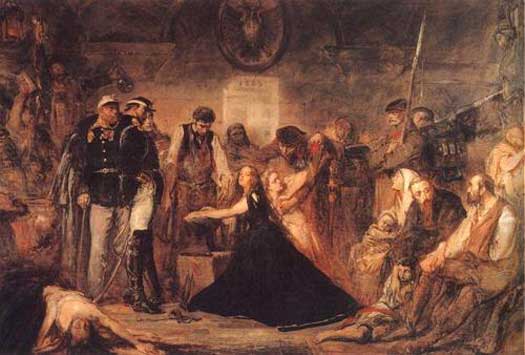 The January Uprising took place across the former Polish-Lithuanian Commonwealth as a result of Russian occupation and control, but the last of its leaders were captured in 1865 The January Uprising took place across the former Polish-Lithuanian Commonwealth as a result of Russian occupation and control, but the last of its leaders were captured in 1865 |
|
| 1865 - 1866 |
Konstantin von Kauffmann |
Later governor of Turkmenistan. |
| 1866 - 1868 |
Eduard |
Count Baranov. |
| 1868 - 1874 |
Aleksandr L'vovich Potapov |
Russian statesman. |
| 1874 - 1880 |
Pytor Pavlovich Albedinsky |
Promoted as general of cavalry. Transferred toWarsaw. |
| 1880 - 1884 |
Eduard (Ivanovich) von Totleben |
Count. Died 1884 near Frankfurt. |
| 1881 |
The first modern-era wave of Jewish Diaspora migrations back to Palestine begins with an event known as the First Aliyah. The Jews are fleeing pogroms in Eastern Europe, most notably in the territories of the Russian empire under Alexander III and his imposition of anti-liberalisation reforms. These may be partially the result of the January Uprising of 1863 (see above). Russia operates an area known as the Pale of Settlement, largely territory to the west which has been acquired from the former Polish-Lithuanian Commonwealth. Today this forms Russia's western border region, and from 1791-1793 it has incorporated modern Belarus (eastern Poland at the time), eastern [Latvia](EasternLatvia.htm#Russian Governors), Lithuania, the province of Bessarabia (modern Moldova), and western Ukraine. The Jewish population of the 'Pale' (mainly Ashkenazi Jews) is restricted from moving eastwards into Russia proper and is now being discouraged from remaining in the western border regions of the empire. Some of their number end up elsewhere in the world, especially the USA, but also[ China](../KingListsFarEast/ChinaDynastiesOld.htm#Manchu Dynasty) where they form the Chinese Jews. |
|
| 1882 - 1884 |
Aleksandr Pavlovich Nikitin |
Acting governor. |
| 1884 - 1893 |
Ivan Semyonovich Kakhanov |
|
| 1893 - 1897 |
Pytor Vasilyevich Orzhevsky |
|
| 1897 - 1901 |
Vitaliy Nikolayevich Trocky |
|
| 1902 - 1904 |
Pytor Dmitriyevich Svyatopolk-Mirsky |
|
| 1903 - 1914 |
The Second Aliyah to Palestine is triggered in 1903 by an anti-Jewish riot in the city of Kishinev (modern Chişinău), the capital of the province of Bessarabia (modern Moldova), part of the Russian empire. Something like forty thousand members of theJewish Diaspora settle in Palestine (mainly Ashkenazi Jews), although only half remain permanently. Many others, evicted from their settlements in the 'Pale' head towards western Poland or America (something that is dramatically highlighted, if with a touch of artistic licence, in the film musical, Fiddler on the Roof, 1971. which has its final scenes set in 1905). 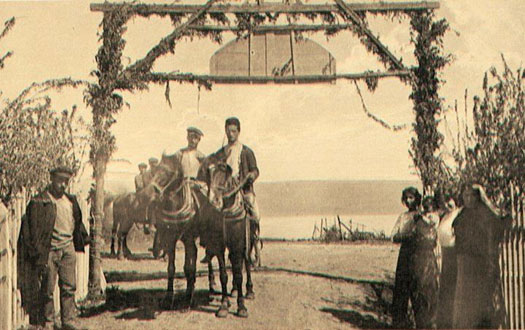 Poland-Lithuania's long-standing Jewish population was gradually forced to emigrate during the later Russian empire period, with most either going west or returning to Palestine Poland-Lithuania's long-standing Jewish population was gradually forced to emigrate during the later Russian empire period, with most either going west or returning to Palestine |
|
| 1904 - 1905 |
Aleksandr Alekseyevich Freese |
|
| 1905 - 1909 |
Konstantin Faddeyevich Krshivicky |
|
| 1909 - 1912 |
The position of governor in Lithuania is vacant. Little seems to have been recorded of the governorship during this period (at least in English), with none of the twentieth century governors being outstanding enough in their careers to be noted in detail. The claim here for a governor between 1912-1915 is speculative, based on the lack of information for any other form of office which may administer the region. It is equally possible that the office is abolished in 1912. |
|
| 1912 - 1915 |
? |
Unknown lastRussian governor? |
| 1916 - 1918 |
Russian First World War defeats of 1916 and 1917 leave the empire in chaos and bring the Baltic Provinces under German imperial control. In 1917, Bolshevik-inspired thoughts of revolution are swiftly put down by the Germans, as are thoughts of independence. Lithuanians elect a German nobleman by the name of Wilhelm of Urach, a member of the royal house of [ Württemberg](GermanyWurttemberg.htm#Kingdom of Wurttemberg), as their king in the hope that this will bring about a form of independence. Instead, Germany's collapse in 1918 forces the creation of a Lithuanian republic. |
|
|
|
|
| Modern Lithuania AD 1918 - Present Day Te modern republic of Lithuania is the largest of the Baltic states, nestling on the eastern shore of the Baltic Sea in Northern Europe. Independent of Soviet Union occupation since 1990, it and its neighbours have proven themselves to be some of the better former Eastern Bloc countries in terms of their economic performance and standard of life, although problems do still exist. Lithuania is neighboured to the north by Latvia, to the east and south by Belarus (making it the only one of the Baltic states not to have a border with Russia), to the south-west by Poland, and to the west by Kaliningrad and - across the Baltic Sea - by Sweden. Lithuania, along with much of modern Latvia, westernmost Russia, northern Belarus, north-eastern Poland, and all of Kaliningrad formed the core territory of the Balts when they migrated into the Early Baltic States area some time around 2,500 BC. Since then the fortunes of the Balts fluctuated, although they remained independent and unconquered until the coming of the German crusaders in the eleventh and twelfth centuries AD. Despite valiant and sometimes suicidal resistance, the Balts were generally subjugated by a Baltic-German aristocracy which continued to wield great influence even during Russian imperial rule. Only the grand duchy of [Lithuania](#Grand Duchy of Lithuania) stood free, but its own failing fortunes forced it to unite with Poland to form the Polish-Lithuanian commonwealth. Even that faded, however, and by the end of the eighteenth century the Baltics were being occupied by Russia. Russian First World War defeats of 1916 and 1917 brought the Baltic states under German imperial control. In 1917, Bolshevik-inspired thoughts of revolution were swiftly put down by the Germans, as were thoughts of independence. Lithuanians elected a German nobleman by the name of Wilhelm of Urach, a member of the royal house of [ Württemberg](GermanyWurttemberg.htm#Kingdom of Wurttemberg), as their king in the hope that this would bring about a form of independence. Instead, Germany's collapse in 1918 brought about the creation of a Lithuanian republic, with any level of German control now being rejected throughout the Baltics. A century and-a-quarter of foreign rule had ended, but Lithuania and Latvia together now covered the smallest ethnographic territory to which the Baltic-speaking people had ever been reduced. (Information by Peter Kessler, with additional information from The History of the Baltic Countries, Zigmantas Kiaupa, Ain Mäesalu, Ago Pajur, & Gvido Straube (Eds, Estonia 2008), and from External Links: The Balts, Marija Gimbutas (1963, previously available online thanks to Gabriella at Vaidilute, but still available as a PDF - click or tap on link to download or access it), and BBC Country Profiles, and Lithuania in the 21st Century, Stanislas Klass (2010), and Translate Easy Baltic (Pasaulio Spalvos), and Lithuania President Nausėda wins landslide re-election (The Guardian).) |
|
|
| 1918 |
Mindaugas II |
Wilhelm of Urach. Rejected and never crowned. |
| 1918 |
The brutal conflict of the First World War fades out with imperial Germany collapsing amid unrest and the abdication of the kaiser. After briefly considering a German king, Lithuania now takes the opportunity to ditch any kind of rule by the German aristocracy and instead forms a republic, with the country's act of independence being signed on 16 February 1918. In order to defend that act, the Lithuanian Wars of Independence must now be faced, first against Bolshevik forces in December 1918-August 1919. |
|
| 1919 |
Lithuania, fresh from pushing back the Bolsheviks must fight off the Bermontians (the West Russian Volunteer Army under the command of Cossack General Pavel Bermont-Avalov). The enemy is now a German-backed force that is involved in the Russian Civil War. Instead of focussing on that, it is intent on retaking Latvia and Lithuania, a desire which sees it heavily defeated in November by the home forces. The Russo-Polish War is ignited between Poland and Ukraine on one side and Soviet Russia on the other over the creation of the Second Polish Republic and the somewhat uncertain borders on its eastern flank. Polish Chief of State Józef Piłsudski considers this the best opportunity to restore Poland to its former greatness (meaning the regaining of at least part of the vast territory of the Polish-Lithuanian commonwealth), and he leads his troops into both Vilnius (part of the fairly brief Polish-Lithuanian War) and Kyiv. |
|
| 1920 - 1921 |
The Polish-Lithuanian War is briefly fought over the control of Vilnius. With Poland the victor, the short-lived 'Republic of Central Lithuania' is formed (later to be transformed into a Polish voivodeship). Red Army pressure causes the Poles to fall back temporarily, but Józef Piłsudski leads his forces to a notable victory against the Soviet Union at the Battle of Warsaw. As the Poles again advance, a ceasefire is agreed with the Soviets in October 1920 and Vilnius is regained (to be held until 1939). The Peace of Riga is signed on 18 March 1921, which formally divides disputed territory between the Soviets and Poles, and which states that the easternmost parts of Lithuania remain part of Poland, including Vilnius. |
|
| 1940 - 1944 |
Although the country is occupied by Soviet forces as agreed under the Molotov-Ribbentrop Pact in 1940, the German army swiftly occupies Lithuania until 1944. The country's populace is forced to rely on its strong Catholic traditions and memories of independence to survive this and the next occupation. |
|
| 1944 - 1987 |
The Soviet army repels the German forces and re-establishes control in Lithuania. At the same time, the country regains Vilnius and the easternmost territories, which had been lost to Poland in 1919. Lithuanian society and industry are modelled along Soviet lines and absolute control rests with the Soviet Communist Party. The United Kingdom and most other western countries never recognise de jure the Baltic states' incorporation into the USSR. |
|
| 1989 - 1991 |
Remaining defiant against Soviet rule and given a level of freedom by the Perestroika reforms of the Soviet Union, Lithuanians take part in a growing movement of passive resistance which culminates on 23 August 1989 with a major section of the country's population holding hands in an unbroken chain which connects to similar chains in Estonia andLatvia. In the same year, the Supreme Soviet of the USSR adopts a resolution on the 'Occupation of the Baltic states', in which it declares that the occupation had been 'not in accordance with law', and not the 'will of the Soviet people'. On 11 March 1990, Lithuania becomes the first Soviet republic to declare its renewed independence. The following year the declaration becomes fact as Poland, Lithuania and Belarus finally regain independence with the fall of the Soviet Union. Former [East Prussia](EasternPrussia.htm#East Prussia), renamed Kaliningrad, remains directly part of Russia, and is now an isolated coastal enclave wedged between Poland and Lithuania. |
|
| 2003 - 2004 |
The Lithuanian people are very much in favour of joining the European Union, as they demonstrate in May 2003, when sixty-four percent of the population turns out to vote. An incredible ninety-one percent of those vote in favour of membership. In 2004 Lithuania becomes a member both of the European Union and of Nato, two important events in the country's modern history. On the other hand, internal politics does not fare so well, with the incumbent president being impeached for violating the nation's constitution as well as his presidential oath. 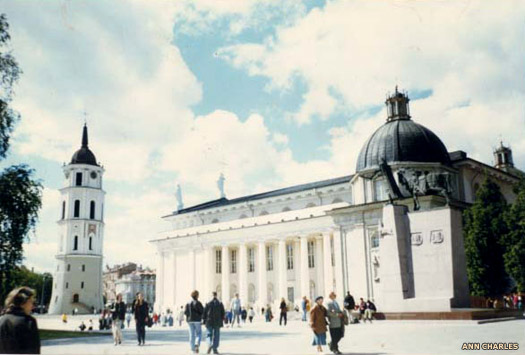 The modern Cathedral of Vilnius is the fourth of its kind, all built one on top of the other in successive phases of rebuilding, mostly after fires had wrought great damage on the previous version The modern Cathedral of Vilnius is the fourth of its kind, all built one on top of the other in successive phases of rebuilding, mostly after fires had wrought great damage on the previous version |
|
| 2007 |
In November the title 'European of the Year' is awarded to the Lithuanian president - no small achievement. In December the country joins the Schengen zone which permits travel to and from the other Schengen countries without any border restrictions. Also in December, the Lithuanian Television and Radio Commission places a ban on any broadcasting of the ratio station, the Voice of Russia. |
|
| 2024 |
Lithuania's President Nausėda wins a landslide re-election in a vote which is shaped by fears about a freshly militaristic and imperialisticRussia. The invasion of Ukraine has triggered much rethinking of defence policies in Europe. The position steers defence and foreign policy, and attends EU and Nato summits, but must consult the government and parliament on appointing the most senior officials. Relations with troublesome eastern partners has been causing some friction in that parliament. |
|
 |
|
|
 Lithuanian rulers held the title of 'kunigaikshtis', which can translate equally into 'duke' or 'king'. Later, however, the word 'karalius' was used to specifically denote a king. This is based on a Slavic derivative of 'Carolus', better known as Charles the Great or Charlemagne (the German/Russian use of Kaiser/Czar descends in much the same way from 'Caesar'). Even though their state was considered to be a grand duchy by Europe in general, the Lithuanian rulers always referred to themselves as kings. Some of their names have varied spellings, thanks to their being recorded by different authors in different languages. The name of the country itself may stem from a river name (see feature link). (Additional information by Gediminas Kiveris, Yury Kanavalau, Eglė Daunoravičiūtė, and Leitgiris Living History Club, from The History of the Baltic Countries, Zigmantas Kiaupa, Ain Mäesalu, Ago Pajur, & Gvido Straube (Eds, Estonia 2008), from The Horse, the Wheel, and Language: How Bronze-Age Riders from the Eurasian Steppes Shaped the Modern World, David W Anthony, and from External Links: The Balts, Marija Gimbutas (1963, previously available online thanks to Gabriella at Vaidilute, but still available as a PDF - click or tap on link to download or access it), and Leitgiris.)
Lithuanian rulers held the title of 'kunigaikshtis', which can translate equally into 'duke' or 'king'. Later, however, the word 'karalius' was used to specifically denote a king. This is based on a Slavic derivative of 'Carolus', better known as Charles the Great or Charlemagne (the German/Russian use of Kaiser/Czar descends in much the same way from 'Caesar'). Even though their state was considered to be a grand duchy by Europe in general, the Lithuanian rulers always referred to themselves as kings. Some of their names have varied spellings, thanks to their being recorded by different authors in different languages. The name of the country itself may stem from a river name (see feature link). (Additional information by Gediminas Kiveris, Yury Kanavalau, Eglė Daunoravičiūtė, and Leitgiris Living History Club, from The History of the Baltic Countries, Zigmantas Kiaupa, Ain Mäesalu, Ago Pajur, & Gvido Straube (Eds, Estonia 2008), from The Horse, the Wheel, and Language: How Bronze-Age Riders from the Eurasian Steppes Shaped the Modern World, David W Anthony, and from External Links: The Balts, Marija Gimbutas (1963, previously available online thanks to Gabriella at Vaidilute, but still available as a PDF - click or tap on link to download or access it), and Leitgiris.) The arrival in Poland of the Gothic people in the first and second centuries AD has a great impact on the Baltic population there, resulting in them moving towards eastern Lithuania. In all probability, due to the ethnic affinity of these peoples, peaceful relations are established. The appearance of various new groups of pottery, part of the Willenberg culture, testifies to the further merging of these ethnic groupings. The ancestors of the Galindians, Lets, Lithuanians, Natangians, Sambians, and Semigallians continue throughout the entire Early Iron Age to build stone cists in which they place urns of a family or kin, covering them with an earth barrow secured by a stone pavement from above and stone rings around. While available, Middle and Late La Tène fibulae are also imported and imitated. In marked contrast to Celtic and Germanic graves, however, weapons are extremely rare in Baltic graves. The inland Prussian tribes seem to live a rather peaceful life. Other Baltic tribes are now developing their own distinctive burial rites. Sudovians build stone barrows, Couronians place their dead in stone circles or rectangular walls, while their neighbours in central Lithuania use flat graves supporting tree-trunk coffins with stones. The differentiation of local burial rites from around this time permits modern scholars the chance of perceiving tribal borders between the various Baltic tribes, which thereafter remain unchanged in this region until the coming of the Germans. Until then, there is no evidence of migrations, shifts of population, or invasions of the Baltic lands by foreign peoples.
The arrival in Poland of the Gothic people in the first and second centuries AD has a great impact on the Baltic population there, resulting in them moving towards eastern Lithuania. In all probability, due to the ethnic affinity of these peoples, peaceful relations are established. The appearance of various new groups of pottery, part of the Willenberg culture, testifies to the further merging of these ethnic groupings. The ancestors of the Galindians, Lets, Lithuanians, Natangians, Sambians, and Semigallians continue throughout the entire Early Iron Age to build stone cists in which they place urns of a family or kin, covering them with an earth barrow secured by a stone pavement from above and stone rings around. While available, Middle and Late La Tène fibulae are also imported and imitated. In marked contrast to Celtic and Germanic graves, however, weapons are extremely rare in Baltic graves. The inland Prussian tribes seem to live a rather peaceful life. Other Baltic tribes are now developing their own distinctive burial rites. Sudovians build stone barrows, Couronians place their dead in stone circles or rectangular walls, while their neighbours in central Lithuania use flat graves supporting tree-trunk coffins with stones. The differentiation of local burial rites from around this time permits modern scholars the chance of perceiving tribal borders between the various Baltic tribes, which thereafter remain unchanged in this region until the coming of the Germans. Until then, there is no evidence of migrations, shifts of population, or invasions of the Baltic lands by foreign peoples.  The mouth of the Vistula in the first century AD was an ideal route for settlement for groups coming south from Scandinavia, but also for groups migrating along the coast such as the speculated movement of Venedi Celts
The mouth of the Vistula in the first century AD was an ideal route for settlement for groups coming south from Scandinavia, but also for groups migrating along the coast such as the speculated movement of Venedi Celts The annals of the town of Quedlinburg in Germany report the arrival of Saint Brunon, known more normally as Bonifatius, on missionary work among the Prussians. His attempt ends in failure, and it is believed he is killed together with his eighteen companions somewhere in the vicinity of the Lithuanian border (the first mention of 'Lithuania' in written sources).
The annals of the town of Quedlinburg in Germany report the arrival of Saint Brunon, known more normally as Bonifatius, on missionary work among the Prussians. His attempt ends in failure, and it is believed he is killed together with his eighteen companions somewhere in the vicinity of the Lithuanian border (the first mention of 'Lithuania' in written sources).  By about AD 1000 the final locations of the Baltic tribes were well known by the Germans who were beginning their attempts to subdue and control them, although the work would take a few centuries to complete and the Lithuanians would never be conquered by them (click or tap on map to view full sized)
By about AD 1000 the final locations of the Baltic tribes were well known by the Germans who were beginning their attempts to subdue and control them, although the work would take a few centuries to complete and the Lithuanians would never be conquered by them (click or tap on map to view full sized) Lithuania's rivers have not only defined at least parts of its borders since its foundation, but one of them may even have provided the country with its name
Lithuania's rivers have not only defined at least parts of its borders since its foundation, but one of them may even have provided the country with its name This artist's impression shows a typical Lithuanian wooden castle from this period during which the land was filled with them, approximately 450 in all, held by the nobility against the duchy's powerful enemies
This artist's impression shows a typical Lithuanian wooden castle from this period during which the land was filled with them, approximately 450 in all, held by the nobility against the duchy's powerful enemies Veiselga Monastery, shown here in oils by Napoleon Orda, was apparently founded by Vaisvilkas, who twice retired to live a monastic life
Veiselga Monastery, shown here in oils by Napoleon Orda, was apparently founded by Vaisvilkas, who twice retired to live a monastic life By around AD 1300 the Swedes and Norse had taken full control of southern Scandinavia and were starting to extend their influence northwards, while the Swedes were also becoming heavily involved in what is now southern Finland (click or tap on map to view full sized)
By around AD 1300 the Swedes and Norse had taken full control of southern Scandinavia and were starting to extend their influence northwards, while the Swedes were also becoming heavily involved in what is now southern Finland (click or tap on map to view full sized) Moscow fought a series of wars against the then-dominant Grand Duchy of Lithuania & Ruthenia (the latter being western Rus) during the fifteenth century, but Moscow's eventual victory would present it with new threats, such as the Tartars of the powerful Crimean khanate (click or tap on image to view full sized)
Moscow fought a series of wars against the then-dominant Grand Duchy of Lithuania & Ruthenia (the latter being western Rus) during the fifteenth century, but Moscow's eventual victory would present it with new threats, such as the Tartars of the powerful Crimean khanate (click or tap on image to view full sized) The Mongol empire created by Chingiz Khan gradually broke up over the course of three hundred years until, by around AD 1500, it had fragmented into several more-or-less stable khanates which vied for power and influence, while fending off the Ottoman empire to the south and Moscow state to the north (click or tap on map to view full sized)
The Mongol empire created by Chingiz Khan gradually broke up over the course of three hundred years until, by around AD 1500, it had fragmented into several more-or-less stable khanates which vied for power and influence, while fending off the Ottoman empire to the south and Moscow state to the north (click or tap on map to view full sized) The death of Sigismund II Augustus, the last hereditary Lithuanian ruler of Poland as depicted by Jan Matejko, which signalled the end of Lithuania's independence from Poland
The death of Sigismund II Augustus, the last hereditary Lithuanian ruler of Poland as depicted by Jan Matejko, which signalled the end of Lithuania's independence from Poland This map shows the Nordic borders following the conclusion of the Great Northern War in 1721, after which large swathes of eastern territory changed hands (click or tap on map to view full sized)
This map shows the Nordic borders following the conclusion of the Great Northern War in 1721, after which large swathes of eastern territory changed hands (click or tap on map to view full sized) French grenadiers of the line defend against an attack by Prussian infantry in the three-day Battle of Leipzig in October 1813, dubbed the 'Battle of the Nations' due to the number of states involved, in this 1914 painting by Richard Knötel
French grenadiers of the line defend against an attack by Prussian infantry in the three-day Battle of Leipzig in October 1813, dubbed the 'Battle of the Nations' due to the number of states involved, in this 1914 painting by Richard Knötel The January Uprising took place across the former Polish-Lithuanian Commonwealth as a result of Russian occupation and control, but the last of its leaders were captured in 1865
The January Uprising took place across the former Polish-Lithuanian Commonwealth as a result of Russian occupation and control, but the last of its leaders were captured in 1865 Poland-Lithuania's long-standing Jewish population was gradually forced to emigrate during the later Russian empire period, with most either going west or returning to Palestine
Poland-Lithuania's long-standing Jewish population was gradually forced to emigrate during the later Russian empire period, with most either going west or returning to Palestine The modern Cathedral of Vilnius is the fourth of its kind, all built one on top of the other in successive phases of rebuilding, mostly after fires had wrought great damage on the previous version
The modern Cathedral of Vilnius is the fourth of its kind, all built one on top of the other in successive phases of rebuilding, mostly after fires had wrought great damage on the previous version